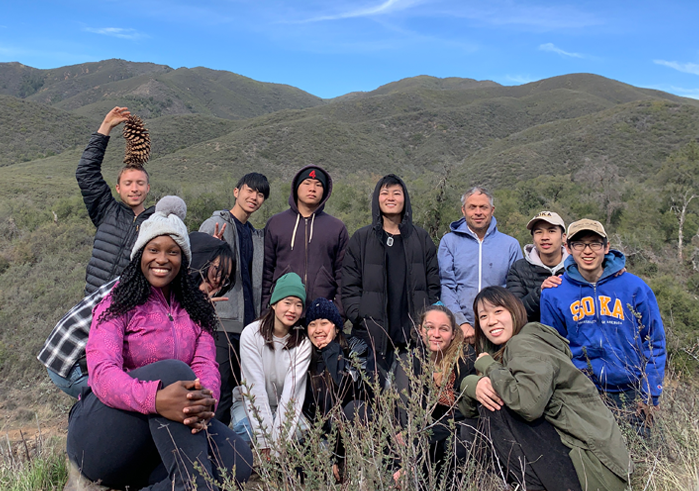Learning Cluster Students Find Meaning in the Wilderness of Orange County

Twelve Soka students and their professor recently scaled a 4,513-foot mountain and faced a vast expanse of green and silence stretching for miles below.
This elevated experience in nature was neither an extracurricular club activity nor a sporting event, but rather the culmination of one of Soka’s unique curricular offerings—the Learning Cluster.
Learning Cluster classes are intensive three-and-half-week sessions conducted during winter block. The courses are co-designed by students and faculty and allow a deeper examination of subjects of all kinds.
During a four-hour hike to Laguna Beach, Chaerin Her ’24 realized how inspirational the outdoors could be for one’s mind and body. They began formulating an idea for a Learning Cluster class that would center on hiking and the exploration of nature. Word spread, and before long, students who’d heard about their idea began reaching out.
When it became clear there was sufficient interest in a Learning Cluster centered on exploring nature, the group approached Robert Hamersley, professor of environmental biogeochemistry, and asked him to lead it. As an outdoorsman who truly enjoys nature, Professor Hamersley readily agreed to the students’ proposal. However, his experience in the wild also heightened his awareness of the challenges associated with taking 12 students on long hikes, especially when some had no previous experience in long-distance hiking.
Many meetings were held before the class commenced to carefully plan its structure. Once classes began, students spent time in the Soka Instructional Garden learning how to chop wood with an axe, identify plant species, navigate with a compass, and read topographic maps, among other outdoor survival skills.
The classes also incorporated readings and journal writing. Students’ journal entries served as a form of self-research, containing reflections from readings, hikes, and class discussions alongside pictures and other external resources.
Parallel to this preparatory phase, students participated in four hiking trips. What began as two- to three-hour-long hikes gradually ramped up to five or six hours. These trips prepared students for the hike at Los Pinos, the fourth highest peak in Orange County, on the second day of a four-day camping trip to Blue Jay Campground in the Santa Ana Mountains, east of the SUA campus, as the culmination of the Learning Cluster.
The class split into three groups during the camping trip. Each group was responsible for making its own breakfast and lunch and took turns cooking dinner for the entire class. For many students, this was their first time sleeping in tents, baking bread on coals, and eating marshmallows around a campfire.
Although some students were exhausted upon returning to Soka, many reported gaining a new awareness during the trip.
“I had no idea that humans could affect nature so much,” said Mark Okuda ’24. “Humans are so tiny, and nature is so big. It is crazy what humans can do. Just bringing a seed that happened to be sticking on our shoe could bring an invasive species, destroying the native plants present.”
For the final project, each student presented on a topic of their choice related to nature. Presentation topics included celestial navigation, the mental health benefits of looking at fire, the benefits of natural fragrances, and the overall benefits of being in contact with nature.
On the final day of the Learning Cluster, the class reflected on the three weeks. At one point in the discussion Professor Hamersley said, “Comfort is often overrated, and discomfort is often underrated.”
Judging by the fondness and humor with which they spoke of the trials and rigors they’d experienced together outdoors, the students clearly agreed.
—Nugnandini Chhetri ‘25
